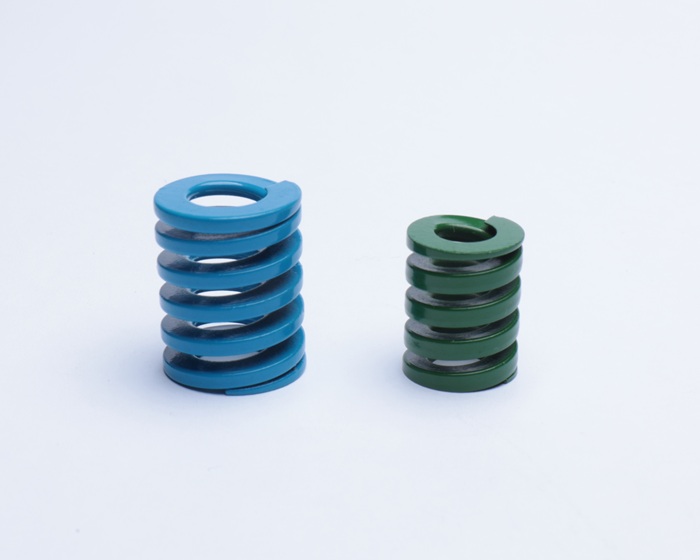壓簧
壓簧

弘志鈎環彈簧五金有限公司 電話:02-2688-4168
壓簧的特性與應用——機械與工業中的核心彈性元件
引言
在現代機械工程與工業製造領域中,彈簧是一種不可或缺的零件,而壓簧(Compression Spring)作為彈簧的一種,憑藉其高效能的回彈力與承受壓縮負載的特性,廣泛應用於各種機械、汽車、電子設備及精密儀器中。壓簧的主要功能是吸收衝擊、儲存能量並釋放彈力,從而確保機械系統的穩定性與安全性。本文將深入探討壓簧的結構特點、製造工藝、應用領域及未來發展趨勢。
壓簧的結構與特點
壓簧是一種螺旋狀的彈簧,其基本結構由高強度金屬絲繞製而成,通常呈現圓柱形,但也可以根據不同的應用需求設計成圓錐形、異形或其他特殊形狀。壓簧在受到外力壓縮時會縮短,當外力釋放後便會恢復到原始形狀,提供一定的回彈力。
壓簧的主要特點包括:
高強度與耐久性:壓簧通常採用碳鋼、不鏽鋼、鎳合金或鈦合金等材料製造,經過熱處理與表面強化後,具備優異的抗疲勞性與耐磨損特性。
良好的彈性回復性能:壓簧的螺旋結構使其能夠均勻地承受壓縮應力,並在壓縮釋放後迅速回復至原始形狀,確保長期穩定運作。
可承受較大負載:壓簧可以根據應用需求設計成不同剛度與負載能力的型號,以適應各類設備的需求,從輕型壓簧到高強度壓縮彈簧皆可客製化生產。
結構緊湊,易於安裝:壓簧相較於其他類型的彈簧(如拉簧或扭簧),通常不需要額外的固定裝置,只需放置於機構內部,即可發揮彈性作用。
壓簧的製造與品質控制
壓簧的製造過程涉及多個精密步驟,包括材料選擇、線材成形、熱處理、表面處理及品質檢測等。
材料選擇 壓簧的性能取決於所使用的金屬材料,常見的材料包括:
碳鋼:適用於一般機械與工業應用,具備良好的彈性與強度。
不鏽鋼:耐腐蝕性強,適用於潮濕或高溫環境,如醫療設備與食品機械。
鎳合金與鈦合金:適用於極端環境,如航空航太、深海探測等領域。
線材成形 壓簧的形狀主要透過數控彈簧機或手動繞製機成形,根據不同需求,可製作不同線徑與圈數的壓簧。
熱處理 為了提高壓簧的彈性與耐用性,需進行熱處理(如淬火與回火),使金屬結構更具韌性,減少長期使用時的疲勞損壞。
表面處理 為了增強壓簧的抗腐蝕能力,常進行磷酸鹽處理、電鍍、噴塗或氧化處理,以提升耐久性與抗氧化性。
品質檢測 壓簧的品質檢測至關重要,常見的測試包括:
彈力測試(確認壓縮後的恢復力是否符合標準)
疲勞測試(模擬長期使用情境,測試壽命)
尺寸精度測試(確保符合設計規格)
壓簧的應用領域
壓簧的廣泛應用涵蓋機械製造、汽車工業、電子設備、航空航太及醫療設備等領域。
機械設備
用於各類機械裝置的減震與緩衝系統,如壓力閥、彈簧夾具、壓力機等。
於高精度機械中,壓簧可作為穩定負載的核心元件,確保運作平順。
汽車工業
壓簧在車輛懸吊系統中扮演關鍵角色,能夠吸收道路顛簸,提高乘坐舒適性。
用於剎車系統、離合器裝置與引擎內部,以增強運行穩定性。
電子與電器
於電池接觸片、按鈕開關等小型電子元件中,壓簧確保良好的導電性與回彈力。
在微機電系統(MEMS)中,壓簧提供精確的彈性控制,適用於高科技儀器。
航空航太
用於飛機起落架、座椅減震裝置等高負載環境,確保飛行安全。
於衛星與航太設備中,提供彈性支持與耐高溫特性。
醫療設備
於精密手術工具、牙科設備、醫療泵浦等器械中,壓簧確保高精度運作與可靠性。
未來發展與創新
隨著科技的不斷進步,壓簧的設計與應用也將持續創新,未來的發展趨勢包括:
新型材料的開發:如超彈性合金、記憶金屬等,提升壓簧的耐用性與適應能力。
智能彈簧技術:利用傳感器與智能控制技術,使壓簧具備自適應功能,應用於自動化與機器人領域。
綠色製造技術:透過高效能生產工藝與環保材料,降低製造過程中的碳排放與能源消耗。
結論
壓簧作為一種重要的彈性元件,在機械、汽車、電子、航空航太及醫療設備等領域發揮著關鍵作用。其高強度、耐衝擊、彈性回復快等特性,使其成為工業設計中不可或缺的零件。隨著新材料與智能技術的發展,壓簧的應用將更加廣泛與精密,為未來工業與科技發展提供更多可能性。